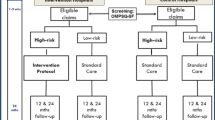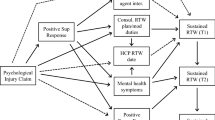Problem: One of the key players in the return-to-work (RTW) and work accommodation process is the healthcare provider (HCP). This study examines the association between RTW approximately one month post injury and early, proactive HCP communication with the patient and workplace. Methods: In this cross-sectional study 187 Ontario workers completed a telephone survey 17–43 days post injury. All had accepted or pending lost-time claims for back, neck or upper extremity occupational musculoskeletal injuries. Logistic regression was used to analyze the effects of three self-reported items “your HCP told you the date you could RTW,” “your HCP advised you on how to prevent re-injury or recurrence,” “your HCP made contact with your workplace” on self-reported RTW. Fourteen potential confounders were also tested in the model including sex, age, income, education, occupational classification, worksite size, co-morbidity, psycho-physical work demands, pain, job satisfaction, depression, and time from injury to interview. Results: The HCP giving a patient a RTW date (adjusted OR=3.33, 95% CI=1.62–6.87) and giving a patient guidance on how to prevent recurrence and re-injury (adjusted OR=2.71, 95% CI=1.24–5.95) were positively associated with an early RTW. Contact by the HCP with the workplace was associated with RTW, however, this association became weaker upon adjusting for confounding variables (crude OR=2.11, 95% C1=1.09–4.09; adjusted OR=1.72, 95% CI=0.83–3.58). Interpretation: Our study lends support to the HCP playing an active role early in the RTW process, one that includes direct contact with the workplace and proactive communication with the patient.

Similar content being viewed by others
Notes
The comparison group was de-identified. The use of WSIB data by the Institute for Work & Health, when not linked to other data, is allowed under strict conditions as stipulated in a research agreement. It should also be noted that it is probable that due to initial WSIB misclassification of injury, a small percentage of individuals in the comparison group do not have back, neck and upper extremity injuries.
REFERENCES
Carey TS, Hadler NM. The role of the primary physician in disability determination for social security insurance and workers’ compensation. Ann Intern Med 1986; 104(5): 706–710.
Dobyns JH. Role of the physician in workers’ compensation injuries. J Hand Surg 1987; 12A(5 Part 2): 826–829.
Dasinger LK, Krause N, Thompson PJ, Brand RJ, Rudolph L. Doctor proactive communication, return to work recommendation, and duration of disability after a workers’ compensation low back injury. J Occup Environ Med 2001; 43(6): 515–525.
Rossignol M, Suissa S, Abenhaim L. Working disability due to occupational back pain: three year follow-up of 2300 compensated workers in Quebec. J Occup Med 1988; 30(6): 502–505.
Pransky G, Katz JN, Benjamin K, Himmelstein J. Improving the physician role in evaluation work ability and managing disability: a survey of primary care practitioners. Disabil Rehabil 2002; 24(16): 867–874.
Best practices in disability management and return to work. The Occupat Environ Med Report 2002; 16(8): 57–69.
Cole DC, Mondloch MV, Hogg-Johnson S. Listening to injured workers: how recovery expectations predict outcomes–a prospective study. CMAJ 2002; 166(6): 749–754.
Hildebrandt J, Pfingsten M, Saur P, Jansen J. Prediction of success from a multidisciplinary treatment program for chronic low back pain. Spine 1997; 22(9): 990–1001.
Scheel IB, Hagen KB, Herrin J, Carling C, Oxman AD. Blind faith? The effects of promoting active sick leave for back pain patients: a cluster-randomized controlled trial. Spine 2002; 27(23): 2734–2740.
Keogh JP, Gucer P, Gordon JL, Nuwayhid I. Patterns and predictors of employer risk-reduction activities (ERRAs) in response to a work-related upper extremity cumulative trauma disorder (UECTD): reports from workers’ compensation claimants. Am J Ind Med 2000; 38: 489–497.
Côté P, Clarke J, Deguire S, Frank JW, Yassi A. Chiropractors and return-to-work: the experiences of three Canadian focus groups. J Manipulat Physiol Ther 2001; 24(5): 309–316.
Coverage under the Ontario Workplace Safety and Insurance Act. 1–10, 2002. Toronto, Ontario, Workplace Safety and Insurance Board.
Beaton DE. Examining the clinical course of work-related musculoskeletal disorders of the upper extremity using the Ontario workers’ compensation board administrative database. Toronto: University of Toronto, 1994.
Gaudette LA, Richardson A, Huang S. Which workers smoke? Health Rep 2003; 10(3): 35–45.
Jaroszynski G, Cassidy JD, Cote P, Carroll L, Zeber J, Yong-Hing K. Development, reliability and concurrent validity of a new self-assessed co-morbidity scale, 1996.
Smith BH, Penny KI, Purves AM, Munro C, Wilson B, Grimshaw J et al. The chronic pain grade questionnaire: validation and reliability in postal research. Pain 1997; 71: 141–147.
Dasinger LK, Krause N, Deegan LJ, Brand RJ, Rudolph L. Physical workplace factors and return to work after compensated low back injury: a disability phase-specific analysis. J Occup Environ Med 2000; 42(3): 323–333.
Von Korff M, Shapiro S, Burke JD, Teitlebaum M, Skinner EA, German P et al. Anxiety and depression in a primary care clinic. Comparison of Diagnostic Interview Schedule, General Health Questionnaire, and practitioner assessments. Arch Gen Psychiatr 1987; 44(2): 152–156.
Von Korff M, Jensen MP, Karoly P. Assessing global pain severity by self-report in clinical and health services research. Spine 2000; 25(24): 3140–3151.
Von Korff M, Dworkin SF, Le Resche L. Graded chronic pain status: an epidemiologic evaluation. Pain 1990; 40(3): 279–291.
Von Korff M, Ormel J, Keefe FJ, Dworkin SF. Grading the severity of chronic pain. Pain 1992; 50(2): 133–149.
Radloff LS. The CES-D scale: A self-report depression scale for research in the general population. Appl Psychol Measure 1977; 1(3): 385–401.
Boyd JH, Weissman MM, Thompson WD, Myers JK. Screening for depression in a community sample. Arch Gen Psychiatr 1982; 39: 1195–1200.
Himmelfarb S, Murrell SA. Reliability and validity of five mental health scales in older persons. J Gerontol 1983; 38: 333–339.
Sayetta R, Johnson D. Basic data on depressive symptomatology, United States, 1974–75. DHEW (PHS) 80–1666. 1980. Washington, D.C., United States Government Printing Office, Public Health Services.
Hogg-Johnson S, Cole DC, Early claimant design group, prognostic. modeling workgroup. Early prognostic factors for duration on benefits among workers with compensated occupational soft tissue injuries. Occup Environmen Med 2003; 60(4): 244–253.
Schade B, Semmer N, Main CJ, Hora J, Boos N. The impact of clinical, morphological, psychosocial and work-related factors on the outcome of lumbar discectomy. Pain 1999; 80: 239–249.
Ash P, Goldstein SI. Predictor of returning to work. Bull Am Acad Psychiatr Law 1995; 23(2): 205–210.
Newcomer MK, Shaw MJ, Williams DM, Jowell PS. Unplanned work absence following outpatient colonoscopy. J Clin Gastroenterol 1999; 29: 76–78.
Loisel P, Abenhaim L, Durand P, Esdaile JM, Suissa S, Gosselin L, Simard R, Turcotte J, Lemaire J. A population-based, randomized clinical trial on back pain management. Spine. 1997; 22: 2911–2918.
Dasinger LK, Krause N, Deegan LJ, Brand RJ, Rudolph L. Duration of work disability after low back injury: a comparison of administrative and self-reported outcomes. Am J Ind Med 1999; 35(6): 619–631.
Hogg-Johnson S, Cole DC, Côté P, Frank JW. Staging treatment interventions following soft tissue injuries. In Sullivan T ed., Injury and the new world of work. Vancouver: UBC Press, 2000, pp. 201–218.
Krause N, Frank JW, Dasinger LK, Sullivan T, Sinclair SJ. Determinants of duration of disability and return to work after work-related injury and illness: Challenges for future research. Am J Ind Med 2001; 40: 464–484.
ACKNOWLEDGMENTS
The authors wish to acknowledge Sheilah Hogg-Johnson and Marjan Vidmar for their useful suggestions and help during the analysis and writing stages. Thank you also to the anonymous reviewers for their feedback.
Author information
Authors and Affiliations
Rights and permissions
About this article
Cite this article
Kosny, A., Franche, RL., Pole, J. et al. Early Healthcare Provider Communication with Patients and Their Workplace Following a Lost-time Claim for an Occupational Musculoskeletal Injury. J Occup Rehabil 16, 25–37 (2006). https://doi.org/10.1007/s10926-005-9009-9
Published:
Issue Date:
DOI: https://doi.org/10.1007/s10926-005-9009-9




